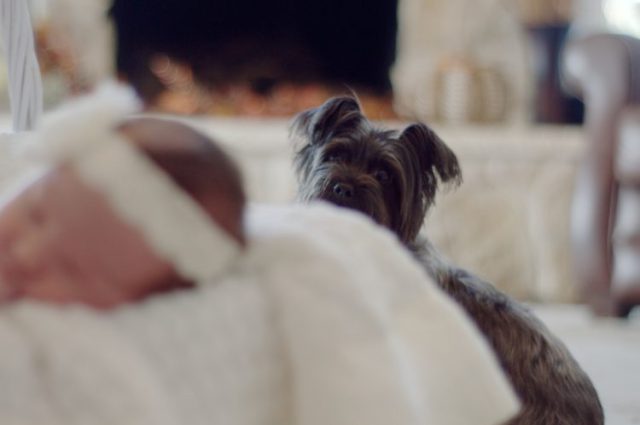For many dogs, the addition of a human baby to the household is a crushing blow. After all, she was your first baby. Here’s the good news: if you start to prepare your dog for the arrival of the baby in the early stages of your adoption or pregnancy, you can give her the support and training she will need to be a model canine citizen.
First thing’s first: it’s never too late to start training your dog. You can take your dog to local classes, such as those offered by the animal shelter or you can follow along with online training videos, such as the ones by Kikopup, my personal favorite.
Step 1: Investigate
Now’s the ideal time to start to think of how your dog asks for attention. Does she bump you with her nose or hit you with her paw when she wants to be petted? Does she jump on you enthusiastically when you come home from work? Will she sit if you ask her to—while you are carrying four bags of groceries or a basket of laundry?
Step 2: Train & Practice
If some alarm bells went off while you were doing your preliminary detective work, don’t worry. With some training and practice, you can make loads of improvement.
Before you decide what types of behaviors you want to train, you need to consider what you want your dog to do when:
- …you’re feeding the baby or changing a diaper
- …you come in the house with the baby for the first time
- …you are carrying the baby in your arms or the baby carrier
Then, you can train the specific behaviors you want your dog to do.
- Do you want her to go lay on a special mat when you are changing a diaper? No problem. Look for online videos with the topic “go to mat.”
- Do you want your dog to do a down-stay while you are feeding the baby? There are videos for that, too.
- Do you want your dog to stop jumping when people come into the house? I’ve got you.
Step 2.5: Getting Used to Equipment
Baby equipment is notorious for swinging, rocking, rolling and making noise. Heck—babies make a lot of noise too, come to think of it. These are all going to be new experiences for your dog, so take advantage of these few months to practice ahead of time.
Start slowly, so you don’t frighten your dog. Gently nudge the rocking chair or stroller and see how your pooch responds. If she has soft body language, you can try more. If her ears go back, her tail tucks or she licks her lips, take it down a notch and help her become more comfortable.
Drop some treats onto the floor when she can see the object, but not when she is close enough for it to make her nervous. If she chooses to investigate, reward her when she returns to you, showing her that she has the choice to approach and retreat as needed.
Once your pooch progresses (and if you don’t feel too silly), take your dog on a walk alongside your empty stroller. You can repeat these same steps while you play baby sounds from your phone or computer. Of course, your baby will sound different from the ones you can find online, but if the dog responds well to the concept, it will help her once her new housemate comes home.
Step 3: Set up Success Stations
This brilliant concept allows the dog to be safely included in your family’s life, while ensuring that the baby remains safe. Help your dog get ready to use a Success Station before baby comes home. Ask yourself:
- Is my dog crate trained?
- Has my pup learned to eat from a frozen Kong?
- Can she relax on the one side of a barrier while she can see you on the other side?
If the answer is yes, then start to practice! If not, work on each of these behaviors separately so that your dog will be ready to go when baby gets home. A new parent is a tired parent—and by using success stations, you are being proactive (#parentgoals!).
If you feel overwhelmed, take a deep breath. Becoming a new parent is a big deal. But with lots of practice, you can set your pooch up for success. You’ve got this.











